Romania’s rural regions stand out not only for their natural beauty but also for their warm human relationships and deep-rooted traditions of hospitality. Village life here is a vivid reflection of the social values and culture of solidarity shaped over centuries. In these villages, far from the concrete urban life, people still consider greeting their neighbors and never sending a guest away empty-handed a matter of honor. Especially in regions like Transylvania, Maramureș, and Bukovina, hospitality is an inseparable part of daily life.
Being a guest in a traditional Romanian village means not only being hosted but also touching the soul of the village. Freshly baked corn bread, homemade cheeses, fruit liqueurs, and warm conversations offered to the guest are among the most natural elements of this culture. Visitors often find that doors open without the need for an invitation and are welcomed with a sincere smile. This hospitality has a deep place in Romania’s cultural identity and continues to live on as a cherished value passed down from generation to generation.
Architectural Details Reflecting the Soul of Village Houses
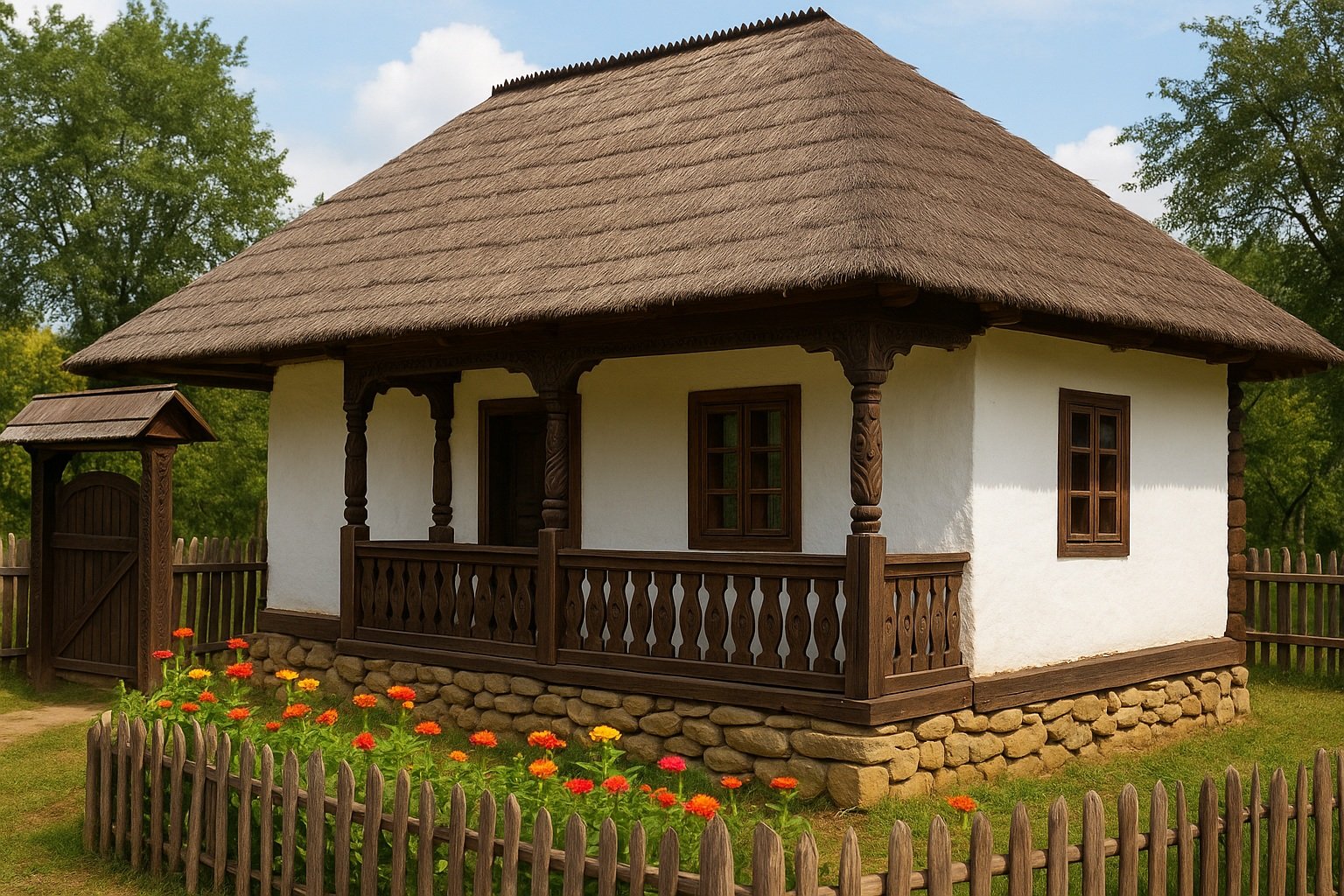
Traditional village houses in Romania’s rural areas are not merely built for shelter; they are living heritage that reflect the region’s cultural, aesthetic, and functional understanding. The use of natural materials such as wood, stone, and adobe in these homes ensures harmony with the environment and creates a connection to the past. In the Maramureș region, houses are notable for their carved wooden doors and decorations, while in Transylvanian villages, colorful window frames, wide eaves, and flower-filled courtyards stand out. Every detail tells the story of the identity of the inhabitants and the regional traditions through an architectural language.
The architectural design of these homes is shaped according to climate conditions and community life. Thick walls provide warmth in winter and coolness in summer, while inner courtyards and wide verandas form the social heart of the household. One room is typically reserved for guests and decorated with the best furnishings. These areas are considered physical representations of hospitality. The architecture of Romanian village houses blends aesthetics and functionality, serving as special structures that carry the traces of the past into modern life.
The First Step in Hospitality: The Doorstep Welcome Ritual
In Romanian villages, hospitality begins even before stepping through the door. The host greeting the guest at the entrance is one of the clearest signs of sincerity and respect. Traditionally, the lady of the house welcomes the guest with freshly baked bread and salt in her hands, sometimes accompanied by a glass of homemade wine or țuică (plum brandy). These offerings symbolize both abundance and goodwill. During the greeting, the guest’s name is spoken with a heartfelt “welcome,” creating the first impression that the guest holds a special place in the home.
This ritual is not merely a traditional greeting but also a reflection of the importance given to hospitality. Especially in rural areas, where this tradition remains strong, it establishes a bridge of trust and warmth between guest and host. During colder seasons, thoughtful gestures such as lighting the stove or preparing slippers to ensure the guest’s comfort are part of this welcoming process. In Romania, a guest who steps through the door is not only a visitor to the home but is also embraced as part of the family.
Homemade Delicacies: The Warmth of Romanian Tables
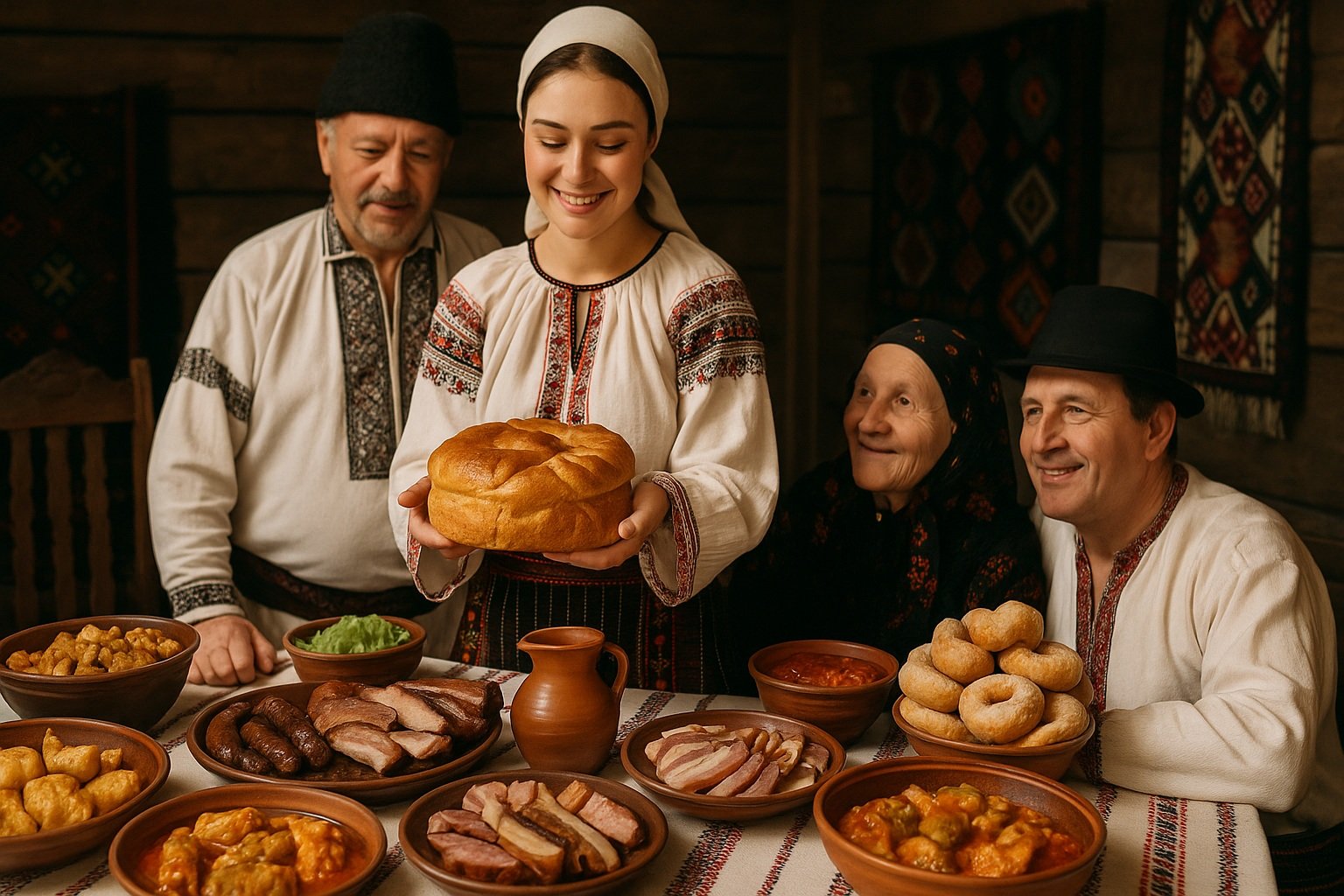
Tables prepared for guests in Romanian villages are not just about food but are a heartfelt form of welcome filled with love and effort. Homemade bread, mămăligă (cornmeal porridge), home-prepared cheeses, pickles, meat stews, and seasonal desserts are essential elements of village meals. These dishes, especially prepared by the lady of the house, are passed down through generations via traditional recipes. Each plate reflects the family’s heritage, local produce, and the spirit of the season. Alongside the food, homemade wine or țuică is often offered, enhancing the conversation and strengthening bonds of friendship.
A meal prepared for a guest is not considered an ordinary dinner but a sign of respect and value. Before sitting down, the phrase “Poftă bună!” (Enjoy your meal) is expressed, highlighting the sense of unity and sharing. In the village, when a guest finishes their plate, it is taken as a compliment to the food and brings joy to the host. The warmth at Romanian village tables comes not only from the dishes but from heartfelt conversations, smiles, and sincere hospitality. For this reason, those who are guests once are often invited again, as the connections formed at the table turn into unforgettable friendships.
Offering Tradition: The Custom of Bread, Salt, and Wine
In Romania’s deep-rooted tradition of hospitality, the trio of bread, salt, and wine is one of the most meaningful symbols of offering. These items are not merely food or drink but represent respect, peace, and friendship toward the guest. Bread symbolizes life and abundance, salt represents loyalty and solidarity, and wine stands for joy and sharing. This traditional offering, presented at the door to special guests in villages, clearly expresses that the guest is warmly welcomed and that the host’s intentions are sincere. Especially during holidays, weddings, or for first-time visitors, this welcoming ritual is practiced with great care.
The origin of this symbolic presentation dates back to the Middle Ages and is still actively preserved in many rural areas. The host offers a piece of freshly baked village bread, sprinkles it with a pinch of salt, and follows with a sip of homemade red wine. This simple yet deeply symbolic offering conveys that the guest is safe, at peace, and truly wanted in the home. In Romania, this tradition reflects both respect for the past and today’s sincere sense of hospitality, living on as part of cultural continuity.
Solidarity and Sharing in the Daily Life of Villagers
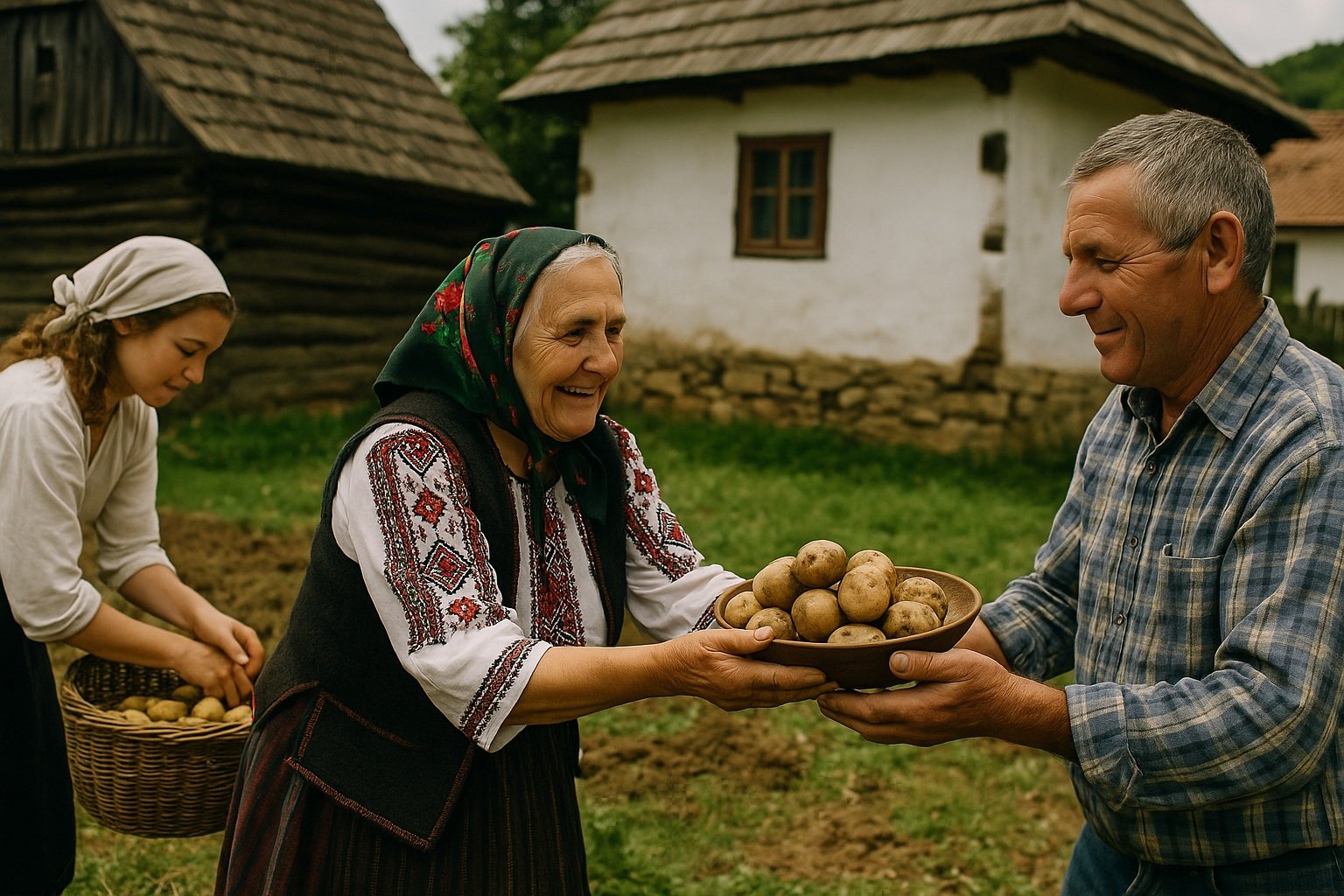
Life in Romanian villages is based more on a sense of community than on individualism. Daily tasks—such as plowing fields, chopping wood, feeding animals, or preparing preserves—are often carried out together with neighbors. This culture of mutual assistance is organized through voluntary collaborations known as “clacă”; when one villager has work to do, others come to help without expecting anything in return. In this way, not only is the workload lightened, but social bonds are also strengthened. This solidarity is present not only in difficult times but also on joyful occasions; during weddings, holidays, and harvests, everyone gathers together.
The culture of sharing is not limited to labor; food, clothing, time, and even stories are shared in village life. Bringing freshly baked bread or newly made jam to a neighboring family is a natural part of daily life. Elders share their wisdom with the young, while children freely play in the gardens of different families. This mutual trust and cooperation establish both economic and emotional balance in Romania’s rural communities. The solidarity-based lifestyle of village people offers a social structure strong enough to serve as an example for modern societies.
Weddings, Holidays, and Hospitality: Open Doors During Celebrations
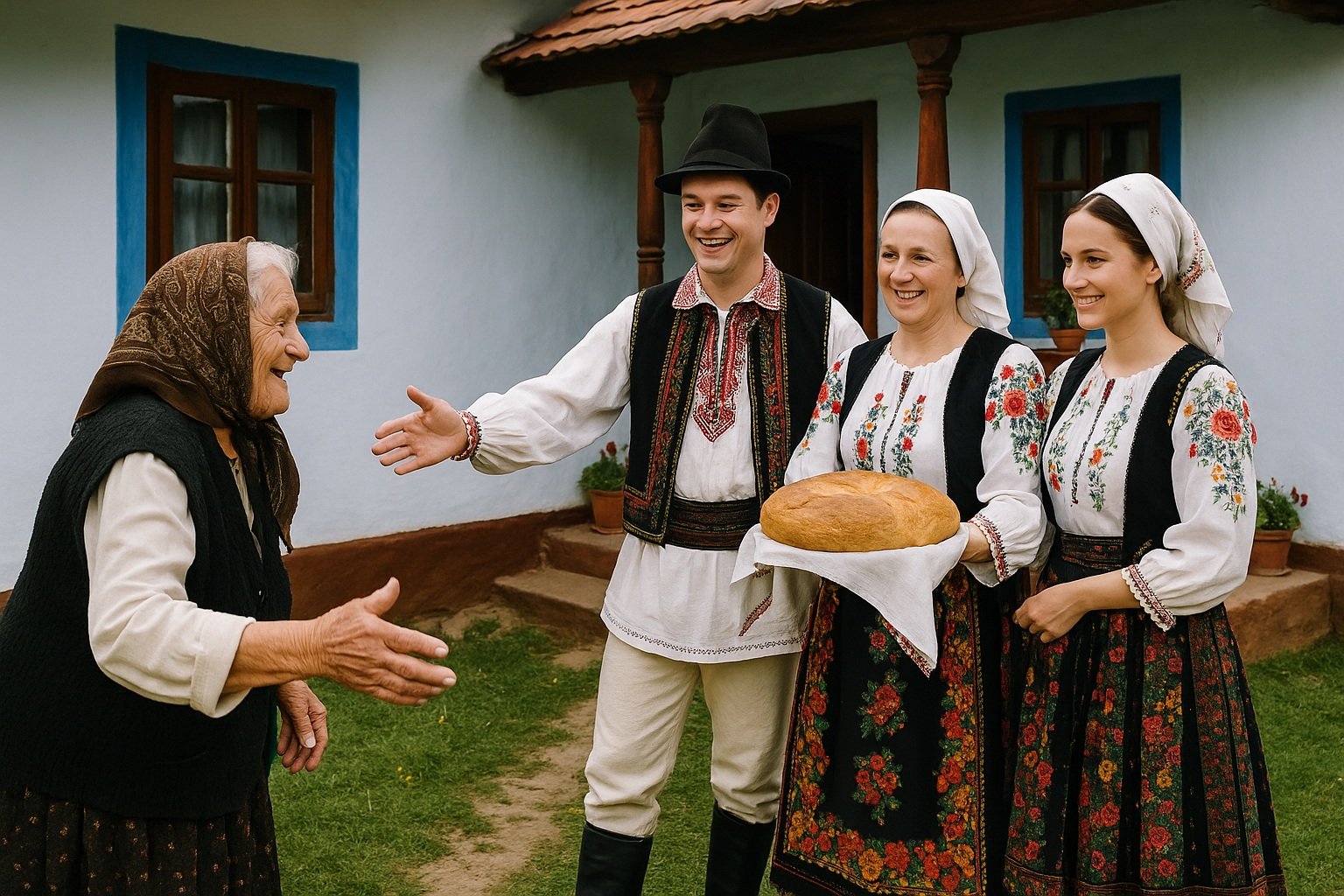
In Romanian villages, weddings, holidays, and special occasions are not only celebrations but also social gatherings where hospitality reaches its peak. On such days, the doors of homes are open not only to close relatives but also to neighbors, friends, and even a passerby. Dozens of people gather around the same table at weddings, traditional clothes are worn, folk dances are performed, and songs are sung. During holidays, homes are cleaned, the best meals are prepared, and everyone offers gifts or treats to one another. These celebrations strengthen solidarity among villagers and turn into unforgettable experiences for guests.
Hosting during celebrations is a source of pride for village residents. Every home takes special care to offer its best room and tastiest food to guests. Traditional treats, heartfelt conversations, and time spent together form the essence of these celebrations. During these times, villages come alive; the streets fill with children’s laughter, and the squares resonate with music. In Romanian village culture, these special days are not just for entertainment but also opportunities to share, connect, and keep cultural values alive. Hospitality lies at the heart of these celebrations.
A Separate Room for the Guest: Being the Guest of Honor in Village Homes
One of the most distinct symbols of the care shown to guests in Romanian village homes is the special room reserved for them. This room is usually the cleanest, most orderly, and best-decorated part of the house. The walls are adorned with embroidered cloths, and the beds are covered with handcrafted linens. This special room not only ensures the guest’s comfort but also reflects the host’s respect, generosity, and devotion to tradition. Especially for guests who have traveled a long way or are being hosted for the first time, this room signifies being an “honored guest” and is offered with great pride.
This tradition shows that in Romania’s culture of hospitality, the guest is not only hosted but is also considered a member of the family. During their stay, all of the guest’s needs are taken into consideration; sometimes special spaces are prepared for their belongings, the stove is lit in advance, and morning coffee is served early. The room reserved for the guest is not just a physical space but also a symbolic place representing the host’s heart and the value placed on the guest. This thoughtful tradition is one of the finest examples of the sincere and warm nature of village life in Romania.
From Children to the Elderly: A Warm Greeting from Every Generation
In Romanian villages, hospitality is not limited to the host; every member of the village, regardless of age, is part of this tradition. Children greet guests by placing their hands on their hearts or imitating their elders with gentle gestures, while the elderly welcome them with warmth and experience. This intergenerational sense of hospitality shows how deeply respect and affection are embedded in the culture. When guests arrive, even the youngest family members help—offering water, preparing the shoe rack, or assisting with setting the table. These practices instill a sense of social responsibility and awareness of hospitality in children from a young age.
The elderly are the source of conversation, stories, and wisdom. Guests often enjoy listening to tales of the past told by elders; these moments are valuable times when both cultural transmission and human bonds are strengthened. In the eyes of the elders, the respect shown to the guest is merged with the preservation of tradition. In Romanian villages, greetings and welcomes are heartfelt, warm, and sincere, regardless of age. Every generation is a link in the chain of hospitality, and this unity gives village life a unique spirit.
From Nature to the Table: Local Products Offered to Guests
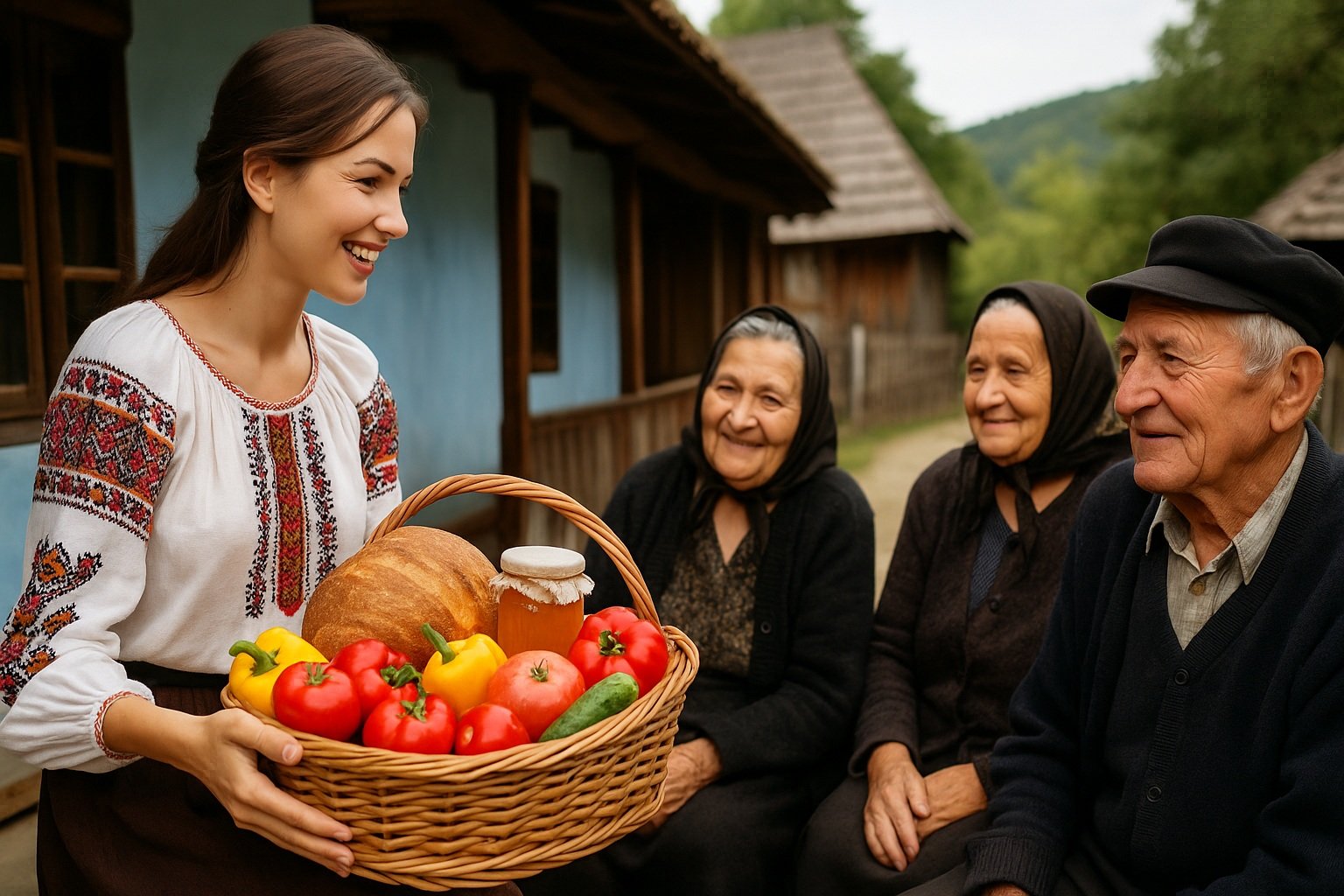
Since life in Romanian villages is lived in close connection with nature, most of the food served at the table comes directly from the field, the garden, or the barn. The products offered to guests are generally homemade, each prepared naturally, without additives, and in accordance with the season. Freshly milked milk, cheeses made with natural cultures, home-smoked meats, tomatoes and cucumbers grown in the garden are among the simplest yet most valuable flavors on the table. In addition, mushrooms, honey, fruits, and jams gathered from the forest are also among the natural offerings presented to guests. These products not only appeal to the palate but also reflect the villagers’ labor and their respect for nature.
Offering local products to guests is not merely about nourishment; it is also a form of cultural sharing. Each plate holds a story, and each bite carries the mark of a season. At this table, the guest does not simply eat; they witness the host’s labor, their bond with nature, and traditional methods of production. For this reason, the tables set in Romanian villages are both simple and meaningful. This chain of flavors from nature to the table is not just a treat offered to the guest but also a warm welcome, a heartfelt greeting, and a shared way of life.
The Role of Traditional Hospitality in Modern Times
Even today, in an age of rapidly advancing technology and changing lifestyles, the traditional understanding of hospitality remains alive in Romanian villages. While in big cities, scheduled meetings, brief visits, or digital communication have become prominent, in village life, adding an extra plate to the table for an unexpected guest is still a sign of naturalness and sincerity. Of course, younger generations have adopted different habits under the influence of modern life, but the culture of hosting guests learned from their elders still holds an important place in daily life. This tradition may take on a different form within homes due to technological transformation, yet it continues to live on without losing its essence.
The most striking aspect of traditional hospitality in modern times is its ability to rebuild the warm bonds between people that are at risk of fading. Gathering around large tables, offering homemade food, and engaging in long conversations—these are not only traditions but also ways to preserve human closeness in a digital age. In Romanian villages, hospitality is not a habit of the past but a living, evolving cultural heritage that does not lose its core values. This is what makes it special and unforgettable for both the local people and visitors.
